Drumstick Farming Detailed Information Guide
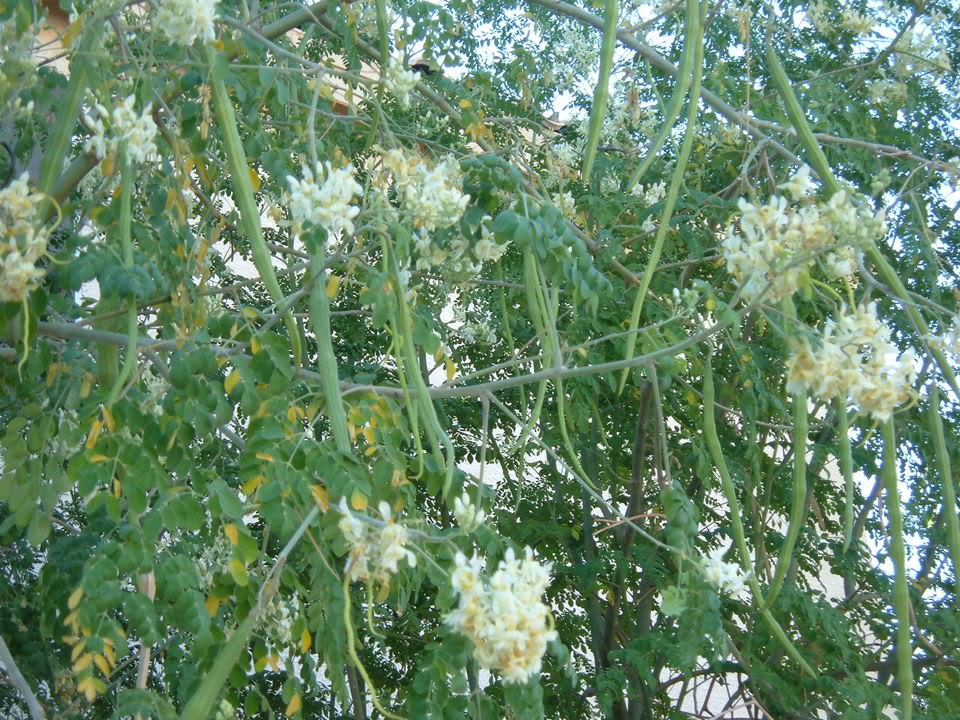
The following information is all about profitable drumstick farming techniques, planting methods, seed rate of drumstick per acre. This also covers Moringa cultivation practices, tips, and ideas. Drumsticks or moringa can be grown in pots, containers, backyard, outdoor gardens even on the terrace.
Drumstick is one of the famous vegetable crops in India. Drumstick scientifically called Moringa oleifera is commonly known as Saijan (Hindi), Shevaga (in Marathi), Murungai (Tamil), Muringnga (Malayalam), and Munagakaya (Telugu) in different Indian languages. Drumstick is the most widely cultivated species of the genus Moringa comes from the Moringaceae family. Though the origin of drumsticks is India, due to their medicinal uses it has reached other countries also. Drumstick tree, Moringa is well known for its multi-purpose attributes, wide adaptability, and ease of establishment. Its leaves, pods, and flowers are all packed with nutrients for both humans and animals. Almost every part of the plant is of food value. Foliage is eaten as green salads and used in vegetable curries. The seeds yield 38-40% of a non-drying oil known as Ben Oil, used for lubricating watches. The oil is clear, sweet, and odorless, never becomes rancid and hence, used in the manufacture of perfumes.
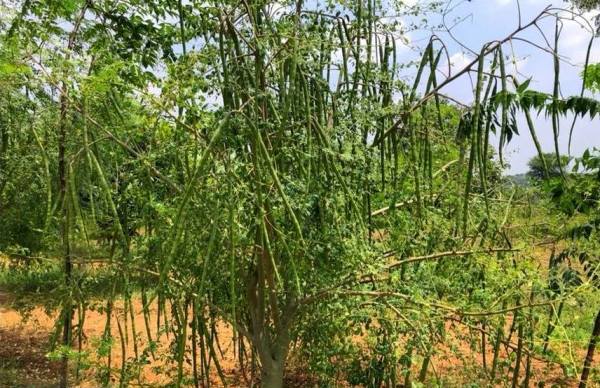
Famous varieties of drumsticks (Moringa):
1) Rohit 1
The first yield starts in 4 to 6 months after plantation & gives commercial yield up to 10 Years. (Per year two seasons). Bears are dark green in color, 45 to 60 cm in length, the pulp is soft & testy, keeping quality is very good. From a single plant, one can get 40-135 drumsticks of about 3 to 10 kg. The yield and quality of drumstick are dependent on climate, soil type, irrigation facility, and spacing and market rates are dependent on quality & demand in the market.
2) Coimbatore 2
The length of the stick is 25 to 35 cm. The stick is dark green in color and tasteful. Each plant yields 250 to 375 sticks. Each stick is bulky. Each plant yields the product for 3 to 4 years. If the product is not taken from the plant earlier, the market value of the product is lost.
3) PKM-1
After plantation, the plant bears flowers and you can yield the product in 8 to 9 months. You can get the production twice a year. Each plant can yield 200 to 350 sticks each plant can yield production for 4 to 5 years. Each stick is larger in length hence the product has demand in the market of big cities rather than local market cost is comparatively less.
4) PKM-2
The raw stick of this variety is greenish in color and tastes good. The length of each stick is 45 to 75cms. Each plant can yield 300 to 400 sticks. This variety yields a good product but requires more water.
Agro-Climatic Conditions for Drumstick Plantation:
The greatness of drumstick is, it can survive in drought conditions with minimal water requirement. they can thrive in poor soils also. The hot and humid climate is suitable for growth and dry climate for flowering. The temperature of 25 to 30 Degrees Celsius is suitable for flowering in the drumstick.
You may be interested in Watermelon Profits, Yield per Acre.
Soil requirement for Drumstick Plantation:
The Moringa/Drumstick plant grows best in well-drained sandy or loamy soil with a slightly acid pH of 6.2 to neutral 7.0. It can tolerate poor soil including coastal areas.
Nursery Raising of Seedlings:
In Drumstick Farming, If you want to use nursery raised plants, use poly bags with dimensions of about 18cm in height and 12cm in diameter. The soil mixture for the sacks should be light, i.e. 3 parts soil to 1 part sand. Plant two or three seeds in each sack, one to two centimeters deep. Keep moist but not too wet. Germination will occur within 5 to 12 days, depending on the age of the seed and the pre-treatment method used. Remove extra seedlings, leaving one in each sack. Seedlings can be out-planted when they are 60-90cm high. When out-planting, cut a hole in the bottom of the sack big enough to allow the roots to emerge. Be sure to retain the soil around the roots of the seedling.
To encourage rapid germination, one of three pre-seeding treatments can be carried out in drumstick farming :
- Soak the seeds in water overnight before planting.
- Crack the shells before planting.
- Remove shells and plant kernels only.
Preparing the Land for Drumstick Plantation:
If planting a large plot it is recommended to first plow the land. Prior to planting a seed or seedling, dig a planting pit about 50cm in-depth and the same in width. This planting hole serves to loosen the soil and helps to retain moisten in the root zone, enabling the seedlings’ roots to develop rapidly. Compost or manure at the rate of 5kg per pit can be mixed with the fresh topsoil around the pit and used to fill the pit. Avoid using the soil taken out of the pit for this purpose: fresh topsoil contains beneficial microbes that can promote more effective root growth. The day before our planting, water the filled pits or wait until a good rain before out-planting seedlings. Fill in the hole before transplanting the seedling. In areas of heavy rainfall, the soil can be shaped in the form of a mound to encourage drainage. Do not water heavily for the first few days. If the seedlings fall over, tie them to stick 40cm high for support
Direct seeding of Drumstick Crop:
If water is available for irrigation (i.e., in a backyard garden), trees can be seeded directly and grown at any time during the year. Prepare a planting pit first, water, and then fill in the pit with topsoil mixed with compost or manure before planting seeds. In a large field, trees can be seeded directly at the beginning of the wet season.
Read this: Spirulina Cultivation Training In India.
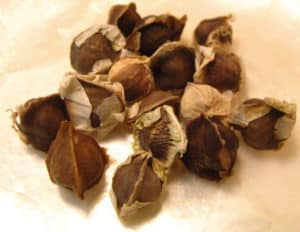
How to grow Drumsticks from Cuttings:
Use hardwood not green wood for cuttings. Cuttings should be 45cm to 1.5m long and 10cm thick. Cuttings can be planted directly or planted in sacks in the nursery. When planting directly, plant the cuttings in light, sandy soil. Plant one-third of the length in the ground (i.e., if the cutting is 1.5m long, plant it 50cm deep). Do not overwater; if the soil is too heavy or wet, the roots may rot. When the cuttings are planted in the nursery, the root system is slow to develop. Add phosphorus to the soil if possible to encourage root development. Cuttings planted in a nursery can be out-planted after 2 or 3 months.
The Drumstick Plant Spacing:
For intensive Drumstick or Moringa production, plant the tree every 3 meters in rows 3 meters apart. To ensure sufficient sunlight and airflow, it is also recommended to plant the trees in an east-west direction. When the trees are part of an alley-cropping system, there should be 10 meters between the rows. The area between trees should be kept free of weeds.
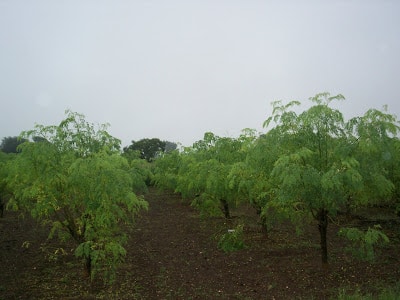
Manures and Fertilizers in Drumstick Farming:
Moringa trees will generally grow well without adding very much fertilizer. Farmyard Manure (FMY) @ 8-10 kg per plant has to be applied to the planting pit 8-10 days before planting of seedlings and 50 kg each of nitrogen, phosphorus, and potash per ha. is to be applied at the time of planting and the same dose is repeated at every six months interval for the crop in drumstick farming.
Irrigation supply for Drumstick Plants:
Moringa/Drumstick plants do not need much watering. In very dry conditions, water regularly for the first two months and afterward only when the tree is obviously suffering. Moringa trees will flower and produce pods whenever there is sufficient water available. If rainfall is continuous throughout the year, Moringa trees will have a nearly continuous yield. In arid conditions, flowering can be induced through irrigation. This crop is quite hardy and during dry season requires irrigation once in two weeks and for commercial cultivation, drip irrigation can be adopted with a daily application rate of 12 to 16 liters of water per tree during summer and half this rate during other seasons. Where water sources are scarce life-saving irrigation or pot watering once in two weeks during a dry period will sustain the crop.
You may also check the Drumstick Farming Project Report, Cost, and Profit.
Pruning of Drumstick Plants:
Pruning of plants can be practiced after one and a half years of planting coinciding with winter months at a height of about 3 feet and allow 4 -5 branches per tree 2 feet above the ground level.
Pests and Diseases of Drumstick:
Drumstick is resistant to most pests. In very water-logged conditions, Diplodia root rot can occur. In very wet conditions, seedlings can be planted in mounds so that excess water is drained off. Cattle, sheep, pigs, and goats will eat Moringa seedlings, pods, and leaves. Protect Moringa seedlings from livestock by installing a fence or by planting a living fence around the plantation. In India, various caterpillars are reported to cause defoliation unless controlled by spraying.
You may also check the Layer Poultry Training In India.
Harvesting of Drumstick:
When harvesting pods for human consumption, harvest when the pods are still young (about 1cm in diameter) and snap easily. Older pods develop a tough exterior, but the white seeds and flesh remain edible until the ripening process begins. When producing seed for planting or for oil extraction, allow the pods to dry and turn brown on the tree. In some cases, it may be necessary to prop up a branch that holds many pods to prevent it from breaking off. Harvest the pods before they split open and seeds fall to the ground. Seeds can be stored in well-ventilated sacks in dry, shady places.
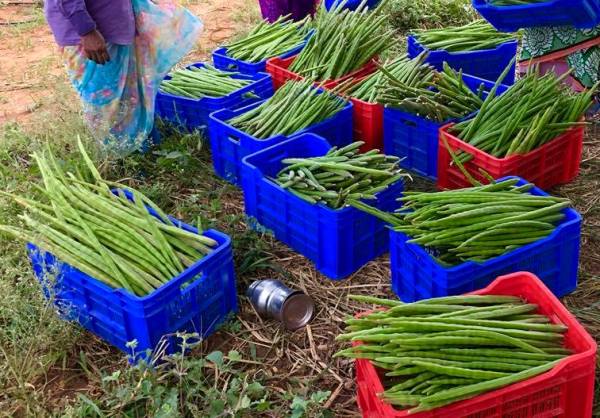
For making leaf sauces, harvest seedlings, growing tips, or young leaves. Older leaves must be stripped from the tough and wiry stems. These older leaves are more suited to making dried leaf powder since the stems are removed in the pounding and sifting process.
The yield of Drumstick:
This basically depends on the seed type/variety cultivated. The yield could be around 50 – 55 tonnes of pods per hectare (220 pods per tree per year).
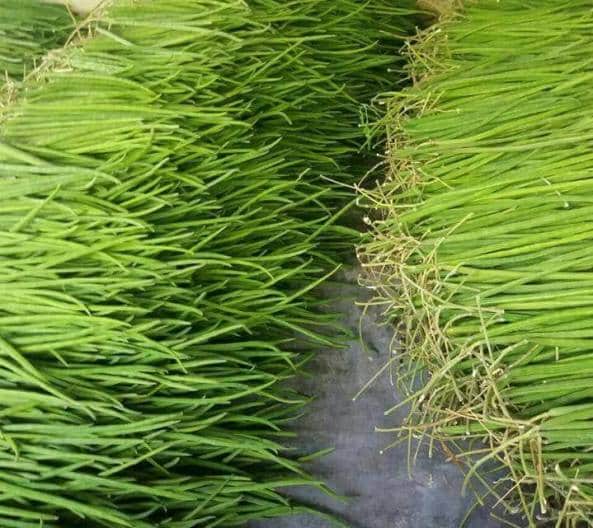
Bottom line:
Drumstick farming is very profitable with minimum Investment and care.
Note: When planting, Always ask a professional local nursery for their opinion and advice about better varieties, risks, and other factors and also fund out local area conditions for Drumstick Farming.
In case if you are interested in this: How To Grow Organic Lettuce.
- Economical Aquaculture: A Guide to Low-Budget Fish Farming
- 15 Common Planting Errors That Can Doom Your Fruit Trees
- How to Make Houseplants Bushy: Effective Tips and Ideas
- Innovative Strategies for Boosting Coconut Pollination and Yield
- Pollination Strategies for Maximum Pumpkin Yield
- The Complete Guide to Chicken Fattening: Strategies for Maximum Growth
- Natural Solutions for Tulip Problems: 100% Effective Remedies for Leaf and Bulb-Related Issues
- Revolutionizing Citrus Preservation: Towards a Healthier, Greener Future
- Natural Solutions for Peony Leaf and Flower Problems: 100% Effective Remedies
- Maximizing Profits with Avocado Contract Farming in India: A Comprehensive Guide
- Natural Solutions for Hydrangea Problems: 100% Effective Remedies for Leaf and Flowers
- The Ultimate Guide to Choosing the Perfect Foliage Friend: Bringing Life Indoors
- From Sunlight to Sustainability: 15 Ways to Use Solar Technology in Agriculture
- The Ultimate Guide to Dong Tao Chicken: Exploring from History to Raising
- The Eco-Friendly Makeover: How to Convert Your Unused Swimming Pool into a Fish Pond
- Mastering the Art of Delaware Chicken Farming: Essentials for Healthy Backyard Flocks
- 20 Best Homemade Fertilizers for Money Plant: DIY Recipes and Application Methods
- How to Craft a Comprehensive Free-Range Chicken Farming Business Plan
- Brighten Your Flock: Raising Easter Egger Chickens for Beauty and Bounty
- How to Optimize Your Poultry Egg Farm Business Plan with These Strategies
- Subsidy for Spirulina Cultivation: How Indian Government Schemes Encouraging Spirulina Farmers
- Ultimate Guide to Raising Dominique Chickens: Breeding, Feeding, Egg-Production, and Care
- Mastering the Art of Raising Jersey Giant Chickens: Care, Feeding, and More
- Ultimate Guide to Raising Legbar Chickens: Breeding, Farming Practices, Diet, Egg-Production
- How to Raise Welsummer Chickens: A Comprehensive Guide for Beginners
- How to Protect Indoor Plants in Winter: A Comprehensive Guide
- Ultimate Guide to Grow Bag Gardening: Tips, Tricks, and Planting Ideas for Urban Gardeners
I want to star Orange farming in chadrapur area. I need a total information about orange cultivation.
Orange farming is like any other citrus farming only like lime farming.
For Orange Farming Guide : CLICK HERE.
I want to start drumstick farming in 1 acre land
Pls tell me good yeilding seeds
Hybrid Drumstick Seed Variety: PKM1.
I am interested in Drumstick farming. How can I get a detailed guide. Please guide me.
You can read Drumstick Farming Project Report.
Need details of buyers of moringa leaf extract & ben oil
I have a problem with Moringa tree. Suddenly the trees attacked by fungus, leaves are going yellow and a spider’s web. Please give me an organic solution.
Here is some information about pests and diseases of drumstick. Read: Drumstick Farming Project Report.
I have 40000 square feet of land with water how to grow drumsticks and I want complete information and guidance
Please go through this: Drumstick Farming Project Report.
How about bhagya drumstick Yeild? I am from Karnataka & interested in drumstick farming.
You can check this: Drumstick Farming Project Report.
Hi,
I am from Assam I would like to do Moringa farming (both for Drum-stick and Leaves). So which breed of seed will be best for farming and from where I will get it. Kindly suggest me. Thanks
Go for PKM breeds.
Is it possible to do drum stick farming in palampur in HP state? Pl give the contact nos for it in HP especially in palampur or around.
Drumstick needs abundant sunshine at least 6 hours of daylight though it can be grown in most of the soil types.
This is a very good website. Very detailed information is provided. Thank you for sharing the information.
Could you please also give information about Alagarsamy Drumsticks variety?
First and Foremost, we thank you for your comments and will be providing vegetable hybrid varieties soon.
Do you know or any idea about someone cultivating Moringa in Assam? Anybody cultivating Moringa in Assam?
I want to plant drumstick for fodder purpose to goats. Which variety will be useful which grows fast or having more branches, leaves.
Hello, i am looking for genuine seeds of PKM1 and Rohit-1 Moringa seeds, most of them claim but ship the common variety seeds, this is for my home farming and not for any commercial interest, please guide me or let me know if you can sell me few seeds of each of this variety, i stay in Bangalore, you can reach me on my email.
hi, i am from nagpur and interested in farming moringa cultivation but dont know its market. Can you guide me.
My father has already planted drumstick plants many years ago.. I just want to know right method to maintain those plants every year for better yield..pls help
please guide me for this type of farming
Hi Mr. Reddy, can drumstick be planted in mango farm? Mango trees are 6 year old and are planted with 20 feet space between each tree.
Well, if you want interplantation of anycrop with mango 20 feet does not work in long run. After 10 years of mango plantation with 20 feet distance, the branches can come closer so it is not advised.
Which moringa verirty is best for saline soil in gujarat coastal area?
Hi Sir,
I am interested in Moringa cultivation, can you please suggest if its good in Mangalore (South Karnataka-Kerala border). Is there anyone growing it successfully in Mangalore?
Hi jagdish,which variety of drumstick seeds are better for cultivation in Telangana state
i have a 50 acre land with water in south gujarat.
can u help for moringa cultivation with buy back assurence?
Moringa farming seems to be encouraging and promising. Wish to know where to get best quality seeds at lowest possible price.
Dear Sir
Good day.
Is any variety of Maringa climate wise Suitable for cultivation in Hoshiarpur district of Punjab
The site provides good and valuable information for beginners in drumsticks farming.
सर. मी रोशन हिंगे. नागपूर. जर मला drumstick farming 2-4 एकर जमिनी वर करायची आहे तर त्यासाठी मी प्रॅक्टिकल नॉलेज साठी कुठे approch करू शकतो. म्हणजे संबंधित अनुभवी व्यक्तिमत्व असल्यास त्यांशी contact मध्ये राहून मी सर्व स्टेप्स घेऊ शकतो यासाठी माहिती हवी आहे . आपलं काही मार्गदर्शन मिळाले तर बर होईल. कारण ही फिल्ड एकदम वेगळी आहे माझ्यासाठी म्हणुन.
Hi Mr Jagdish
Can drumstick farming be done in Black soil?
Yes, as long as there won’t be any water storage at the plant base, you must make sure the excess water should be drained out. In black soils, the frequency of watering is also less when compared to other soils.
I am saiprasad khansole from the district nanded in maharashtra. I am graduate in science . i want to do drumstick farming on 2-4 acres . but i dont have any practical knowldge, so i want practical knowldge about drumstick farming else I wanted to guidence time time from seedling to cutting drumstick.have you any contact from nanded about drumstick farming so i meet him and learn from him.
ok thank you about all information from above.
In which district higest acreage of drum stick is cultivated in A.P&Telangana
I want to to start Moringa farming, planting cultivation, processing Moringa products. in Thoothukudi dt..
pl. suggest me to get detailed project report/ feasibility report preparation consultant.
My bank want DPRfor sanctioning loan.
Waiting for your reply.
With Regards,
A.Nithyanandam
How can det drumstick seed